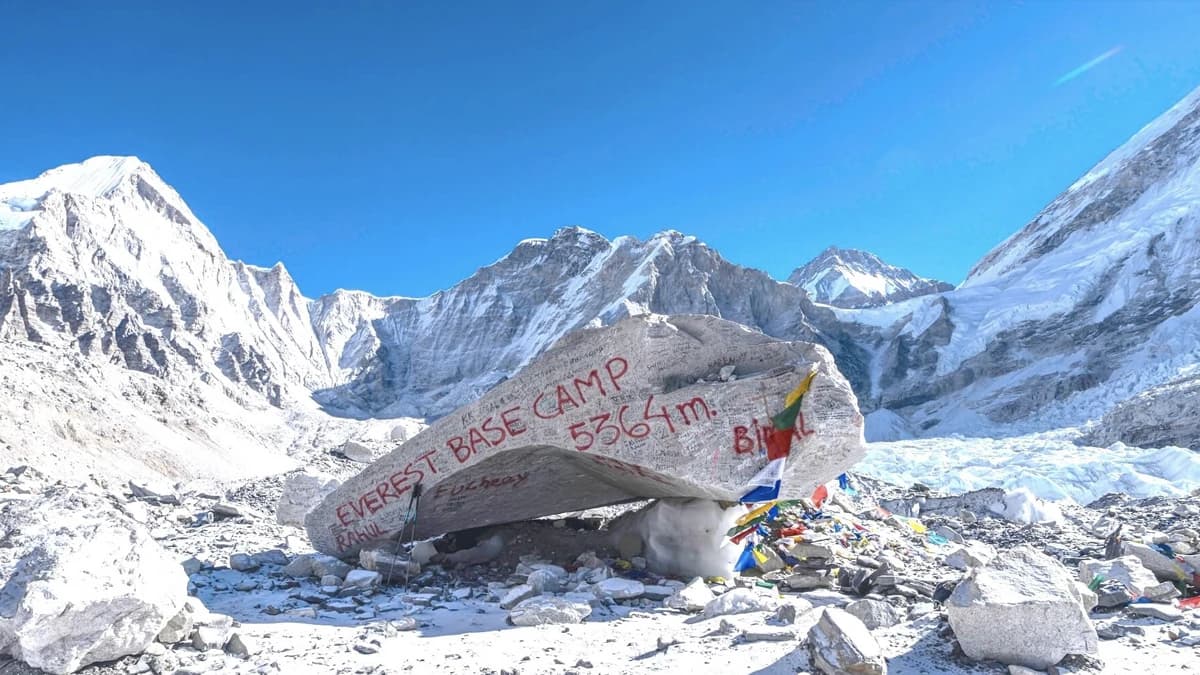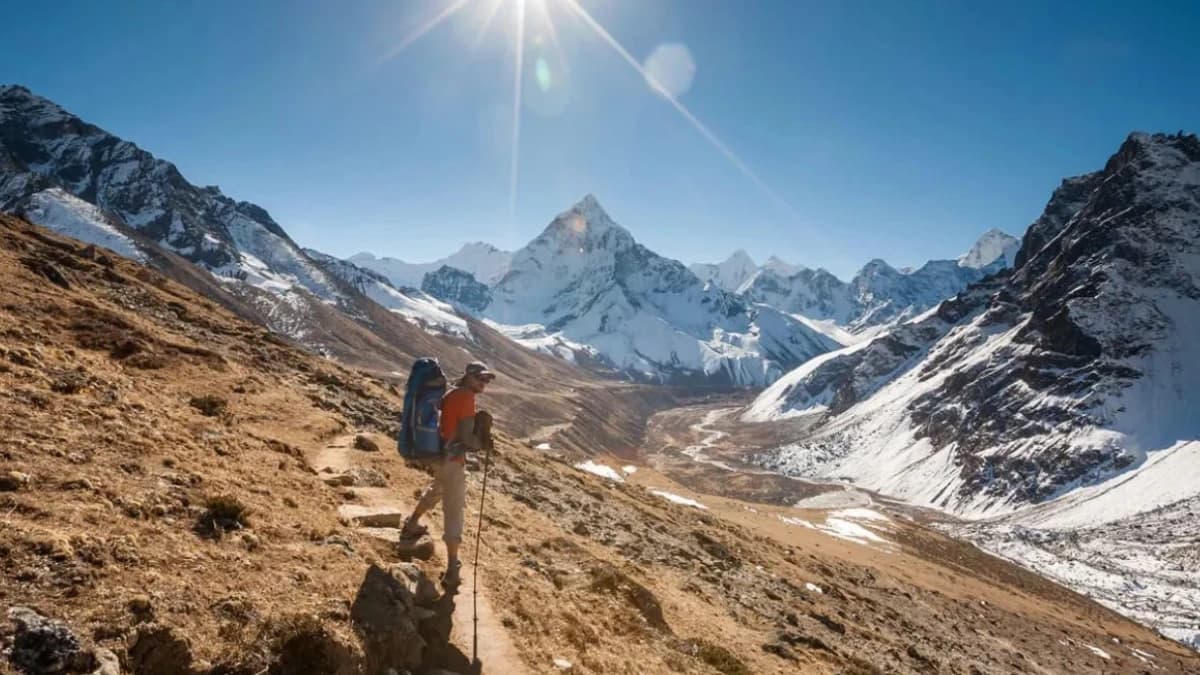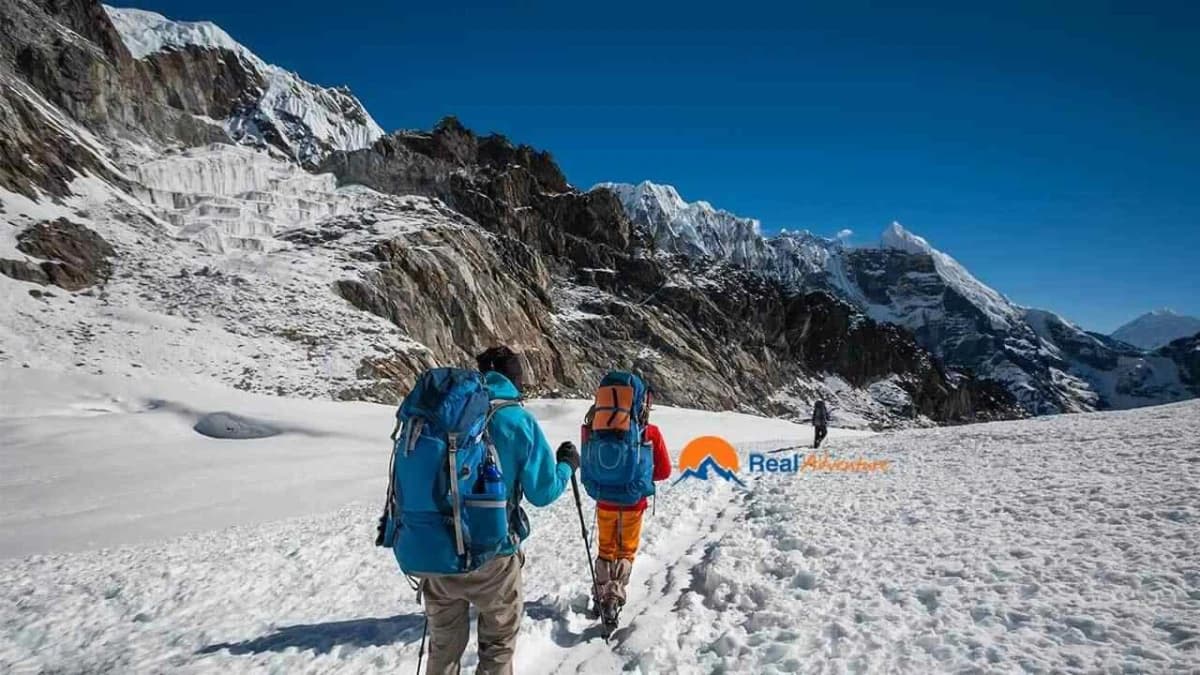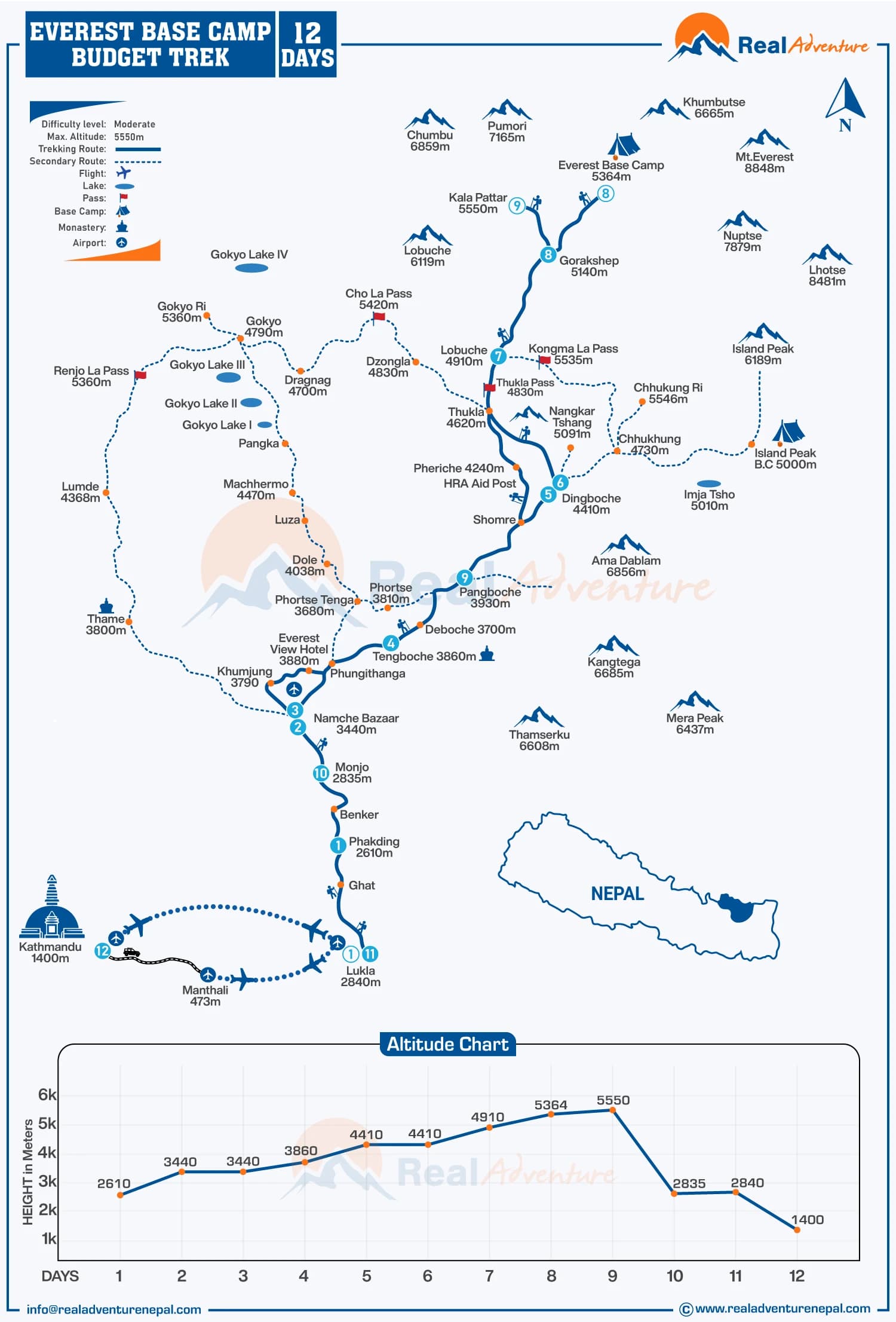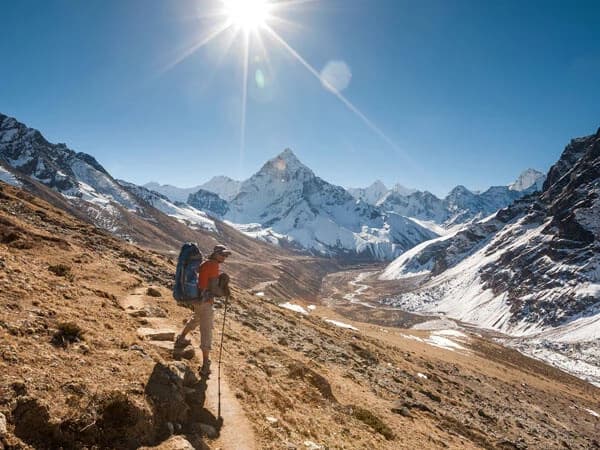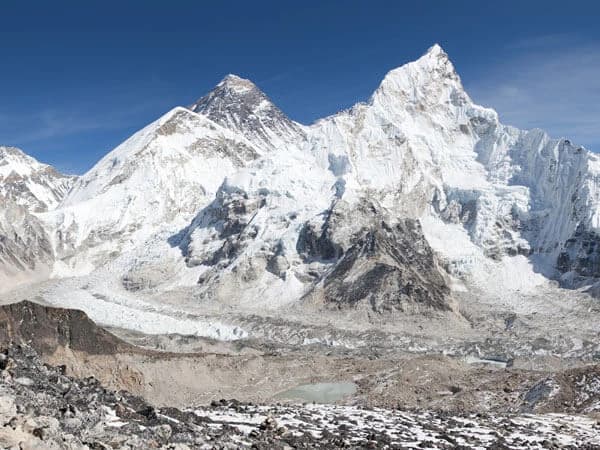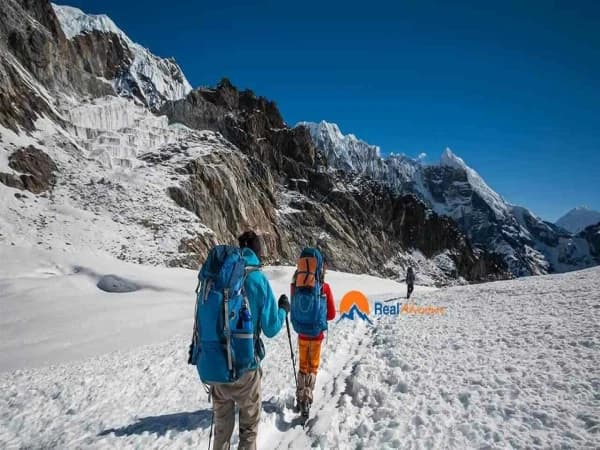Everest Base Camp Trek – A Once in a Lifetime Himalayan Adventure
The 12 Days Everest Base Camp Trek is one of the world’s most iconic trekking experiences, combining jaw-dropping Himalayan landscapes, thrilling high-altitude trekking, and an immersive encounter with the legendary Sherpa culture. This journey through the heart of the Khumbu region offers the perfect balance of challenge, cultural discovery, and breathtaking scenery—making it one of the most sought-after trekking in Nepal adventures.
Your adventure begins with a scenic yet adrenaline-filled flight from Kathmandu to Lukla, home to one of the most famous mountain airstrips on Earth. From here, the trail winds through pristine alpine forests, across suspension bridges above roaring glacial rivers, and past traditional Sherpa villages. The surrounding giants—Mount Everest, Lhotse, Nuptse, and the graceful Ama Dablam—dominate the skyline, creating a photographer’s dream at every turn.
This Everest Base Camp trek is designed for travelers with limited time but a strong desire to experience the magic of the Himalayas. The pace allows for proper acclimatization, improving your chances of reaching Everest Base Camp (5,364m) safely and comfortably while enjoying every cultural and natural highlight along the way.
A key highlight is Namche Bazaar, the vibrant trading hub of the Everest region. Nestled in the mountains, it offers stunning views, lively markets, cozy bakeries, and insightful museums that celebrate Sherpa history. Another unforgettable stop is Tengboche Monastery, a spiritual sanctuary surrounded by snow-capped peaks—an ideal place for reflection in the shadow of the world’s tallest mountains.
The pinnacle moments of the trek are standing at Everest Base Camp, the legendary starting point for summit expeditions, and climbing to Kala Patthar (5,545m) for one of the most spectacular Mount Everest views imaginable. Sunrise from Kala Patthar paints the Himalayas in golden hues, a sight that stays with trekkers forever.
Beyond the scenery, this trek is deeply enriched by the warmth and resilience of the Sherpa people. Nights spent in traditional teahouses offer a genuine taste of mountain life—simple, spiritual, and intimately tied to nature. This cultural connection transforms the trek from a physical challenge into a soulful journey.
The Everest Base Camp Trek – 12 Days itinerary is more than just a hike; it’s a personal achievement, a spiritual experience, and a lifelong memory. Whether you’re a seasoned hiker seeking your next big challenge or a first-time trekker drawn to the allure of Everest trekking in Nepal, this route offers the perfect opportunity to stand at the foot of the world’s highest peak and witness the grandeur of the Himalayas.
Highlights of 12 Days Everest Base Camp Trek from Kathmandu
- Begin your adventure with a thrilling flight to Lukla, known for its challenging airstrip and incredible aerial views of the Himalayas.
- This bustling Sherpa town is the gateway to the high Himalayas. Enjoy local markets, stunning views of Everest, and Sherpa culture.
- Visit this significant monastery for panoramic views of Everest, Lhotse, Nuptse, and Ama Dablam.
- Reaching Everest Base Camp at 5,364 meters is the trek’s highlight, where you stand at the base of the world’s tallest mountain, surrounded by awe-inspiring peaks and the Khumbu Icefall.
- At 5,545 meters, the hike to Kala Patthar offers the best unobstructed views of Mount Everest, especially at sunrise or sunset. Everest Base Camp Trek with Helicopter Return allows you to enjoy these breathtaking views without the long descent.
- Gain insights into Sherpa life, visit monasteries, interact with locals, and experience their warm hospitality.
- Traverse various landscapes, from lush forests to arid high-altitude terrain, showcasing the region’s natural beauty.
- Walk on the famous Khumbu Glacier, adding a sense of adventure to your trek.
- Spot Himalayan wildlife and enjoy blooming rhododendrons in spring within Sagarmatha National Park.
- Feel fulfilled as you reach Everest Base Camp and stand in the shadow of the world’s highest peak.
- Forge lifelong friendships and create lasting memories with fellow trekkers and guides.
Is the 12 Days Everest Base Camp Trek Worth It for First-Time Trekking in Nepal?
The 12 Days Everest Base Camp Trek is absolutely worth it for first-time trekkers who want to experience the best of Everest trekking in Nepal in a short, well-planned itinerary. This route offers world-famous Himalayan views, authentic Sherpa culture, and the chance to walk to the legendary Everest Base Camp (5,364m). Many travelers worry that the EBC trek is only for expert hikers, but thousands of first-time trekkers complete the Everest Base Camp trek every year with proper pacing and acclimatization. The 12-day plan is designed to gradually take you higher, giving your body enough time to adjust to the altitude. Along the trail, you walk through beautiful Sherpa villages, cross thrilling suspension bridges, explore Namche Bazaar, and visit the holy Tengboche Monastery. The highlight for most beginners is reaching Base Camp and climbing Kala Patthar for sunrise views of Mount Everest. The journey also includes comfortable lodges, familiar meals, and clear daily walking distances. For anyone dreaming of standing beneath the world’s highest peak, the 12 Days EBC Trek offers an ideal mix of challenge, safety, and unforgettable scenery—making it one of the best first-time trekking experiences in Nepal.
How Difficult Is the 12 Days Everest Base Camp Trek via Lukla Flight?
The 12 Days Everest Base Camp Trek via Lukla flight is considered a moderate to challenging trek, but it is very manageable for trekkers with normal fitness and a positive mindset. The trek does not require technical climbing skills, but the high altitude, long walking hours, and constant elevation gain make it more demanding than regular hikes. The adventure begins with a scenic flight to Lukla Airport, one of the most famous mountain airstrips in the world. From there, the trail gradually climbs through Phakding, Namche Bazaar, Tengboche, Dingboche, and Gorak Shep. The difficulty mostly comes from trekking above 3,500m, where the air gets thinner. However, the 12-day EBC itinerary includes proper acclimatization days in Namche and Dingboche, which helps your body adjust naturally. Daily walking ranges from 5–7 hours, with some steep uphill and downhill sections. The toughest day is usually the hike to Kala Patthar (5,545m) because of the altitude and early morning cold. Despite the challenges, thousands of first-time trekkers complete the trek successfully. With slow pacing, hydration, and the right gear, the 12 Days Everest Base Camp trek is safe, achievable, and rewarding for both beginners and experienced hikers.
What Are the Best Highlights of the Everest Base Camp Trek – 12 Days Itinerary?
The Everest Base Camp Trek – 12 Days itinerary is packed with unforgettable highlights that attract trekkers from around the world. The journey begins with an exciting flight from Kathmandu to Lukla, offering the first breathtaking views of the Himalayas. As you hike through the Khumbu region, you cross iconic suspension bridges, pass prayer wheels and stone-carved mani walls, and walk through traditional Sherpa villages. One of the biggest highlights is Namche Bazaar, the vibrant Sherpa capital filled with bakeries, shops, museums, and panoramic viewpoints like Everest View Hotel. Another key attraction is Tengboche Monastery, surrounded by Ama Dablam, Everest, and other snow-capped peaks. The spiritual energy of this monastery makes it one of the most loved stops on the trail. The ultimate highlights come toward the end: arriving at Everest Base Camp, the starting point for Everest expeditions, and climbing Kala Patthar for the best sunrise view of Mount Everest. The golden light spreading over Everest, Lhotse, and Nuptse creates one of the most memorable moments of any trek. Along the way, trekkers enjoy Himalayan wildlife, glacial valleys, and genuine Sherpa hospitality. These combined highlights make the 12-day EBC trek a dream adventure.
How Safe Is the Everest Base Camp Trek with Acclimatization in 12 Days?
The Everest Base Camp Trek with acclimatization in 12 days is considered very safe when done with proper guidance and a well-planned itinerary. Acclimatization is the most important part of any Everest trekking in Nepal journey, and the 12-day plan includes essential rest days in Namche Bazaar and Dingboche, where trekkers follow the “hike high, sleep low” principle. These breaks allow your body to adjust to lower oxygen levels and significantly reduce risks related to altitude. The trail to Everest Base Camp is well-marked, well-traveled, and filled with experienced guides, porters, lodges, and emergency support. Most sections of the route are safe and stable, with wide paths and steady climbs. Trekking slowly, drinking enough water, sleeping well, and eating warm meals all contribute to safety on the trail. The presence of rescue teams, communication networks, and medical points in Namche and Pheriche adds another layer of security. The trek becomes even safer when travelers carry travel insurance and follow guide instructions. Overall, with the right acclimatization and mindful trekking pace, the 12 Days Everest Base Camp Trek is one of the safest high-altitude adventures in Nepal.
What to Expect on the 12 Days Everest Base Camp Trek: Views, Culture & Kala Patthar Sunrise?
The 12 Days Everest Base Camp Trek offers a rich combination of panoramic views, deep Sherpa culture, and unforgettable Himalayan moments. From the very first day, trekkers enjoy views of the world’s most beautiful peaks—including Mount Everest, Lhotse, Ama Dablam, Nuptse, and Thamserku. The trail winds through pine forests, glacial rivers, historic monasteries, and legendary Sherpa settlements. You’ll experience local mountain life, prayer flags fluttering in the wind, spinning prayer wheels, and warm teahouse hospitality. As you trek higher into the Khumbu region, the landscapes become more dramatic, with icy valleys and stunning glacier fields. The cultural highlight is visiting Tengboche Monastery, where monks chant prayers against a backdrop of massive Himalayan peaks. The final stretch of the trek brings you to Everest Base Camp, a dream destination for adventurers worldwide. But the most magical moment comes the next morning—climbing Kala Patthar for Everest sunrise. As the first golden light touches the peak of Mount Everest, the entire mountain range glows in shades of gold and orange. This breathtaking sunrise is often described as the most beautiful viewpoint in the Himalayas. Together, the scenery, culture, and emotional achievement make the 12-day trek an unforgettable journey.


